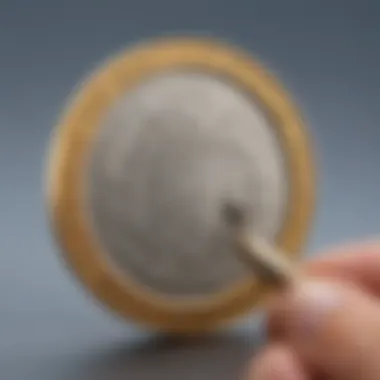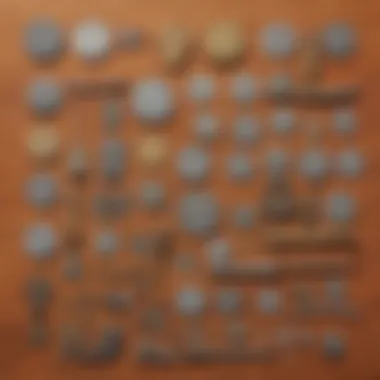The Art of Coin Identification: A Comprehensive Guide


Intro
Coin identification is not only an intriguing hobby but also a skill that enriches our understanding of history and culture. This guide serves as a resource for anyone interested in numismatics, from novice collectors to seasoned enthusiasts. By diving into the techniques, tools, and historical contexts of coin identification, readers will learn how to recognize various coins, determine their value, and appreciate their significance.
Understanding the art of coin identification begins with an exploration of fundamental terminology. Knowledge about basic terms like 'obverse', 'reverse', 'mint mark', and 'die' is essential. More advanced identification methods, such as understanding grading scales and recognizing counterfeit coins, will also be discussed. Collectors can benefit from this knowledge framework, as it will assist them in making informed decisions.
As we move forward, we will touch on innovative activities that spark interest in coin collecting while highlighting the educational benefits of engaging with this fascinating subject. Let's begin by considering some creative avenues that can enhance the learning experience for young enthusiasts, parents, and caregivers alike.
Prelims to Coin Identification
Coin identification serves as a fundamental aspect of numismatics, enabling collectors and enthusiasts to appreciate and understand the intricate world of coins. By facilitating the recognition of different currencies, collectors can gain insights into their historical contexts, values, and numismatic significance. This introduction sets the stage for a more profound exploration of the techniques and considerations essential for accurately identifying coins.
Understanding the Basics
To grasp the art of coin identification, one must first become familiar with its basic principles. Coin identification involves recognizing and categorizing coins based on various characteristics, such as design, composition, and minting techniques. An essential starting point is the understanding of the different types of coins, which include but are not limited to:
- Circulating Coins: Common money used in daily transactions.
- Commemorative Coins: Created to celebrate historical events or figures.
- Bullion Coins: Coins with a high intrinsic value based on precious metals.
- Error Coins: Coins that have manufacturing mistakes, making them unique.
Understanding these categories aids novice collectors in making informed decisions, paving the way for deeper involvement in the hobby. Knowing what to look for is crucial in determining whether a coin is a rare find or a common piece.
Why Coin Identification Matters
Coin identification is not merely an academic exercise; it has practical implications for collectors and investors alike. Accurate identification helps in assessing the value of coins, which can fluctuate based on rarity and demand. Moreover, being knowledgeable in coin identification opens doors to various opportunities, including:
- Trading: Proper identification ensures fair dealings with other collectors.
- Insurance: Accurate records of coin collections can aid in determining their insured value.
- Historical Insight: Each coin tells a story, revealing cultural and historical information that can enrich one’s appreciation of the past.
The skills in identifying coins are vital in the dynamic world of numismatics, where knowledge often translates into value.
In summary, understanding the basics of coin identification and recognizing its importance equips individuals for a rewarding journey in collecting. The art of accurately identifying coins lays a solid foundation for all following discussions in this guide.
Essential Terminology
Understanding the critical terms in coin identification is essential for both novices and seasoned collectors alike. Proper terminology allows one to communicate clearly about specific features, enhance identification skills, and engage in discussions about value and history effectively. Whether examining a recently bought coin or contemplating a family heirloom, knowing the right words is crucial. This section will unfold several common terms you will encounter regularly.
Common Coin Types
Coin types can vary greatly, encompassing diverse designs, sizes, and compositions. Familiarity with these categories is fundamental.
- Circulating Coins: These coins are regularly used in everyday transactions. They usually feature familiar designs, such as those seen in the United States' quarter or penny.
- Commemorative Coins: These are issued to honor specific events or figures. Often, they are made in limited quantities and can be more valuable than standard coins.
- Bullion Coins: Primarily issued for investment purposes, these coins contain precious metals like gold, silver, or platinum. The value often fluctuates according to market prices.
Recognizing these common coin types aids in more effective identification. It also informs decisions about purchases and sales. Being aware of the type assists in estimating a coin’s potential worth, which can differ vastly based on the category.
Understanding Mint Marks
Mint marks are small, sometimes subtle engravings on coins indicating where they were produced. Understanding this can greatly enhance a collector's knowledge and appreciation of each piece.
- Location: The mint mark is typically located on the reverse side. It tells you which mint produced the coin - for example, a 'D' stands for the Denver Mint while a 'S' is for the San Francisco Mint.
- Rarity and Value: Coins from certain mints may be rarer or more sought-after, thus increasing their collectible value. This is especially true for historical or limited-edition releases.
Being attentive to mint marks can also prevent misidentification and ensures proper value assessment when buying or selling. Common errors happen when individuals overlook these crucial indicators, leading to potentially missinvaluable opportunities.


By grasping these essential terms, collectors and enthusiasts can tackle the process of coin identification with greater confidence and accuracy. Understanding the types and mint marks lays a solid foundation for further exploration in numismatics.
Techniques for Coin Identification
Coin identification involves several techniques, each contributing significantly to properly identifying a coin. This section explores essential methods that both novice and experienced collectors can use. Techniques like visual inspection and using reference materials help in effectively identifying coins while also enhancing their overall appreciation. Applying these techniques systematically can ensure accuracy and deepen one’s understanding of numismatics.
Visual Inspection
Visual inspection is often the first step in coin identification. It involves closely observing the physical characteristics of a coin. This method allows collectors to gather essential information about a coin's design and features, helping them make informed decisions about its identification.
Examining Design and Features
Examining design and features is crucial in identifying coins. This process includes studying elements such as the inscription, imagery, and specific engravings. The coins' designs often hold historical significance, as they reflect the era and culture from which they originate. One key characteristic of examining design is its reliability; a keen eye can reveal much about a coin's identity.
The unique feature of this method is that it does not require specialized tools. This accessibility makes it an widely used technique for beginners and seasoned collectors alike. However, examining design can sometimes be subjective. Gathered observations may vary between collectors, which can lead to misidentification if not approached carefully.
Assessing Condition and Wear
Assessing condition and wear adds another layer to coin identification. This aspect focuses on the physical state of a coin, affecting its perceived value. Coins in pristine conditions often command higher prices compared to heavily worn ones. Thus, understanding a coin's wear is vital to its identification.
The key characteristic of assessing condition is its quantifiable measure of desirability. There are established grading systems such as the Sheldon Scale, which help collectors determine a coin's condition objectively. One unique advantage of this technique is its support for market valuation, as collectors can use grading to guide buying and selling decisions. However, reliance on this method alone can be misleading. Factors such as improper cleaning or environmental damage may alter the perceived condition, leading to potential disputes in identification.
Using Reference Materials
Reference materials play a vital role in coin identification. They provide a wealth of information, helping collectors accurately identify coins through reliable resources. Utilizing these materials can significantly reduce the chances of making mistakes in identification.
Numismatic Catalogs
Numismatic catalogs, such as the
Tools for Coin Collectors
Tools are essential for any collector. They assist in the accurate identification of coins, ensuring that enthusiasts can appreciate the details and history behind each piece. Having the right tools enhances the overall experience and helps collectors avoid mistakes. This section looks at key equipment and protective gear that can significantly improve the coin identification process.
Essential Equipment
Magnifying Glasses
Magnifying glasses are vital for examining coins closely. They allow collectors to see intricate details that are otherwise invisible to the naked eye. A good magnifying glass will provide clear, distortion-free images. Collectors often prefer ones with adjustable zoom, which enables them to switch between different levels of magnification.
The key characteristic of magnifying glasses is their optical quality. Look for options with high clarity and durability. This quality makes them a popular choice among coin collectors. A notable feature is the foldable design, which makes it easy to carry around.
While magnifying glasses offer many advantages, some disadvantages exist as well. Lower-quality models may produce a distorted view leading to inaccurate assessments. Therefore, it is vital to invest in a reliable magnifying glass.
Coin Scales
Coin scales are another important tool for collectors. They measure the weight of coins accurately, which helps verify authenticity and assess value. Precision is crucial, as even a slight difference in weight can indicate a counterfeit coin.
A key characteristic of high-quality coin scales is their digital display, providing easy reading. Many scales also include sensitivity features that detect even small weight variations. This makes them a beneficial choice for serious collectors.


However, some coin scales can be pricey and may require battery replacements. Always check the capacity and accuracy ranges to ensure you are buying a scale suitable for your needs.
Protective Gear
Coin Holders and Sleeves
Protective gear plays a pivotal role in preserving the condition of coins. Coin holders and sleeves are designed to protect coins from dirt, moisture, and physical damage. These items are essential for any collector looking to maintain their collection's value.
Coin holders, especially those made from archival-safe materials, keep coins safe without causing any harm. Many collectors appreciate the variety of options available—including capsules, flips, and albums. These holders help in organizing coins while keeping them protected.
One disadvantage is that some holders may not present coins in the best visual way, potentially leading to scratches or tarnishing if not used properly. Therefore, choosing the right type of holder is critical for every collector.
Cleaning Supplies
Cleaning supplies are crucial for maintaining the aesthetic appeal of coins. They help remove dirt and grime without damaging the surface. Certain cleaning solutions are specifically designed for numismatic items, ensuring the safety of the coins while restoring their shine.
The key characteristic of cleaning supplies for coins is their gentleness. Products like microfiber cloths and soft brushes are popular among collectors because they do not scratch the coin surface. Using these tools can keep coins looking pristine without compromising their value.
However, caution is essential when it comes to cleaning. Improper cleaning methods can harm coins, leading to diminished value. Always research before applying any cleaning method to ensure the coin is not damaged.
Always approach coin identification and maintenance with care. Tools and protective measures can make a significant difference in preserving your collection.
Historical Context in Coin Identification
Understanding the historical context in coin identification is crucial for anyone interested in numismatics. Coins are not just monetary objects; they represent significant cultural and historical narratives. Each coin can be a window into the past, showcasing the art, technology, trade, politics, and economies of the times they were minted.
The evaluation of a coin's historical background can enhance its identification process. It allows collectors to appreciate the various significances behind different coins, such as the socio-political environment or economic considerations of the era. Moreover, an understanding of historical contexts aids in discerning counterfeits and recognizing genuine pieces of history.
Understanding Coinage History
Ancient Coins
Ancient coins are often lauded for their intricate designs and historical narratives. They were minted by various civilizations, from Greek city-states to the Roman Empire. These pieces can provide valuable insight into the cultures and practices of ancient societies. One key characteristic of ancient coins is their craftsmanship. Each coin often bears unique designs that reflect the artistic styles and important symbols of the time.
These coins are a beneficial choice for both collectors and historians alike, as they often tell the story of trade routes and the economy of ancient empires. One unique aspect of ancient coins is their historical value. However, they can be more prone to wear and tear, making it crucial for collectors to assess their condition closely. Collecting ancient coins can also be quite challenging due to the potential for forgery, thus requiring a keen eye and thorough research.
Modern Issues
Modern coins, in contrast, represent the more recent advancements in coin production and design. They often include security features that ancient coins lack. One significant aspect of modern coins is that they can be more accessible to collectors. Many mints produce commemorative coins that celebrate important events, people, or anniversaries, appealing to a wide audience.
The key characteristic of modern coins is their mass production and use of new materials, making them more uniform in design and more resistant to wear and tear. This aspect can be advantageous for newcomers, as modern issues are more readily available and easier to identify. However, the downside is that they often lack the unique historical narratives that ancient coins provide, which can be less appealing to some collectors.
Cultural Significance of Coins
Coins have always carried cultural significance beyond their monetary value. They often symbolize national pride and identity, reflecting the values and beliefs of the societies that produce them. Additionally, coins can illustrate the evolution of art and design as societies change and grow.
Common Mistakes in Coin Identification
Coin identification is a nuanced practice requiring both attention to detail and knowledge. When collectors and enthusiasts approach coins, they must be mindful of common missteps that can lead to inaccuracies or missed opportunities. Understanding these mistakes is essential for both new and experienced collectors alike.


Overlooking Details
Many beginners in coin identification often make the grave error of overlooking small details. Coins contain a myriad of elements that can significantly affect their identification and value. For instance, minute variations in design, mint marks, or even the weight of the coin can lead to confusion. A minor scratch or imperfection on the surface should not be disregarded, as such aspects can determine a coin's condition rating.
Collectors should adopt a meticulous approach when examining coins. Using tools such as magnifying glasses can aid in observing features otherwise invisible to the naked eye. This includes identifying errors in minting, which may add considerable value to a coin. By neglecting these details, collectors risk misidentifying valuable pieces or mistaking replicas for genuine currency.
Relying Solely on Photos
In the digital age, it is common for collectors to rely on photographs for coin identification. While images can provide valuable initial insights, they should never be the sole source of information. Photographs can distort the colors and details of a coin, leading to incorrect assumptions about its authenticity and condition.
The subtleties of physical coins may not be captured in a photo. Factors such as feel, weight, and sound when dropped can provide insights that an image cannot convey. Thus, it is crucial for enthusiasts to handle the coins whenever possible. Comparing the actual coin to the reference images can also help confirm details concerning design and mint marks. Inaccurate identification results from an overreliance on visual representations, which may lead to financial losses.
Remember, the art of coin identification is as much about careful observation as it is about searching for knowledge.
By understanding these common mistakes, collectors can enhance their accuracy in coin identification, ensuring they appreciate the true value of their collections. Accurate identification not only fosters a deeper connection with numismatics but also elevates the entire collecting experience.
Resources for Further Learning
In the field of coin identification, having access to additional learning resources is crucial. These resources enhance knowledge, provide different perspectives, and help collectors refine their skills. Beyond the basic understanding of coins, exploring various materials and communities will deepen one’s appreciation and expertise in numismatics. Here, we will discuss two significant areas that offer ample opportunity for growth: books and literature, as well as local and online communities.
Books and Literature
Books are fundamental for advancing any collector’s understanding of coinage. They encompass a vast range of topics, including history, grading, and specific coin series. Collectors can benefit from reading historical accounts of coin production and the economic influences surrounding them. Some reputable titles include "A Guide Book of United States Coins" by R.S. Yeoman and "The Coin Book" by Michael K. Schwartz. These works not only provide detailed information on coin identification but also explore their historical contexts.
Benefits of reading include:
- In-depth knowledge: Books offer thorough explanations and imagery that are often unavailable online.
- Credibility: Many authors are experts in their fields, providing reliable information that enhances understanding.
- Reference material: A good library becomes a valuable asset for quick checks during the identification process.
It is worthwhile to visit libraries or bookstores to find relevant titles. Online platforms also provide downloads and articles, which can be very handy. However, the credibility of online sources must be evaluated to avoid misinformation.
Local and Online Communities
Engaging with local and online numismatic communities can enhance one’s experience in coin identification tremendously. These platforms allow enthusiasts to share insights, ask questions, and learn from each other’s experiences. Local clubs often host meetings that provide social interaction and trade opportunities, while online forums can cater to a more extensive audience.
Consider the following benefits of community involvement:
- Knowledge sharing: Members contribute different perspectives and experiences that can challenge or confirm one’s understanding.
- Networking opportunities: Building connections can lead to learning opportunities, mentorship, and trading coins.
- Access to expertise: Many communities offer advice from seasoned collectors who can guide newcomers in best practices and techniques.
Online platforms such as Reddit and Facebook host numerous groups dedicated to coin identification. These communities encourage participation and offer immediate feedback on queries. Joining such groups aids in expanding one’s network and enhancing learning.
In summary, resources for further learning, including books and community engagement, are essential for anyone serious about coin identification and numismatics.
Ending
In the world of coin identification, understanding various elements is crucial for enthusiasts and collectors. The conclusion wraps up the learning journey we have taken throughout this guide, highlighting the key points and facts that have been discussed and their significance.
Coin identification is not merely a hobby; it is a window into history, culture, and economics. By recognizing the details and features of coins, one can learn about the era they came from, their purpose, and who produced them.
Recap of Key Points
We explored several essential points in this guide:
- The basics of coin identification including terminology and types of coins.
- Techniques such as visual inspection and using reference materials.
- Tools that aid in the process from magnifying glasses to proper storage solutions.
- The historical context and significance of coinage throughout ages.
- Common mistakes to avoid for more accurate identifications.
- Resources to further enhance your knowledge, including books and online communities.
These aspects together create a comprehensive framework for anyone looking to dive deeper into numismatics.
Encouragement for Continued Exploration
As we conclude, it is important to emphasize that the journey of coin identification does not end with this article. Each coin is unique, and the world of numismatics is vast. With every exploration, there is potential to uncover new information, develop skills, and connect with like-minded individuals.
Consider joining local clubs or online forums like those found on Reddit or Facebook to continue learning and sharing experiences.
The more you engage, the richer your understanding will be. Each coin collection holds stories waiting to be discovered. Keep exploring and enjoy every moment of it.







